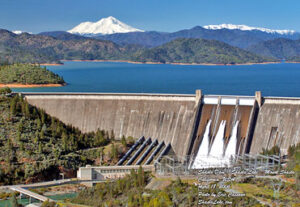Following a series of posts, this is the last post in a series on the lessons learned by the National Marine Fisheries Service (NMFS) from the 2013-2015 drought that devastated Sacramento River salmon populations. This post addresses Lesson #6. The will be the last in the series because the past has become the present, and the focus must now shift to drought conditions and management in 2021 and beyond.1

The best science is that a 53oF daily-average temperature (DAT) is protective of salmon eggs/embryos in their gravel redds in the Sacramento River in the spring and summer spawning season. But the Bureau of Reclamation, without enough pushback from NMFS and the State Water Board, continues to manage for higher water temperatures in the 10-mile spawning reach of the Sacramento River from Keswick Dam (River Mile 300) downstream to the mouth of Clear Creek (RM 290).2
A 53oF DAT is close to the 55oF seven-day-average-daily-maximum temperature (7DADM) that NMFS cited in its Lesson #6, quoted above. The Bureau of Reclamation met that target in wet year 2019 (Figure 1).
Protection was compromised in 2020 (Figure 2), as Reclamation only maintained the 53oF DAT at Clear Creek in the peak mid-summer egg and embryo period. Since the 2019 Biological Opinion, this has become Reclamation’s dry-year strategy. This dry-year strategy is a partial improvement over the prior dry-year strategy of 56ºF DAT at Clear Creek that Reclamation employed in 2015 (Figure 3), when there was very low over-summer survival of eggs and embryos, and very little fry and smolt production, of winter-run salmon.
Water temperatures were even higher in May 2021, reaching 58-62oF early in the month (Figure 4). Such temperatures were high enough to compromise the health and reproductive success of the many pre-spawn adults holding below Keswick Dam. First, elevated water temperatures delay spawning. Second, adults have higher disease vulnerability at water temperatures above 60oF. Third, eggs and embryos from holding adults subjected to water temperatures higher than 60oF have higher pre-hatch mortalities and abnormalities.
With tentative approval by the State Water Board of Reclamation’s draft summer temperature management plan for 2021, we can expect a 56oF DAT at Clear Creek target for the peak June-July egg incubation season. Such operation allows significant hydropower production and water deliveries from Shasta storage releases, as well as water exports from the Trinity River. If these were curtailed, Reclamation could achieve a target of 53oF DAT at Clear Creek and save salmon.

Figure 1. Water temperatures May-October, 2019 in the Sacramento River at Keswick Dam-KWK (RM 300), Redding-SAC (RM 295), Clear Creek-CCR (RM 290), and Balls Ferry-BSF (RM 276).

Figure 2. Water temperatures May-October, 2020 in the Sacramento River at Keswick Dam-KWK (RM 300), Redding-SAC (RM 295), Clear Creek-CCR (RM 290), and Balls Ferry-BSF (RM 276).

Figure 3. Water temperatures May-October, 2015 in the Sacramento River at Keswick Dam-KWK (RM 300), Redding-SAC (RM 295), Clear Creek-CCR (RM 290), and Balls Ferry-BSF (RM 276).

Figure 4. Daily average water temperature in the winter-run salmon spawning reach of the Sacramento River below Keswick Dam (KWK – RM 300) and above Clear Creek (CCR – RM 290) in April-May 2021. Safe level for holding adult salmon for reproduction success is 56ºF. The safe level for disease potential in holding adults is 60ºF.

Figure 4. Water temperatures in the Sacramento River at the lower end of the spawning reach above Clear Creek (CCR), May 1-May 30, 2021.
- https://www.dailykos.com/stories/2021/5/24/2031912/-Endangered-Sacramento-River-winter-Chinook-salmon-are-dying-before-spawning-below-Keswick-Dam; https://www.sfchronicle.com/local/environment/article/Conservationists-say-time-running-out-to-save-16211851.php#photo-20942693 ↩
- Note that NMFS recommends monitoring water temperatures at redd locations where temperatures may be higher than at gaging stations. ↩










 In early April 2021, the Bureau of Reclamation began a series of tests to determine if releases of water that bypass the powerhouses at Shasta Dam could help save Shasta’s cold-water pool through the summer and fall and thus help sustain salmon spawning in the Sacramento River below Shasta. This post describes the third experiment in the series.
In early April 2021, the Bureau of Reclamation began a series of tests to determine if releases of water that bypass the powerhouses at Shasta Dam could help save Shasta’s cold-water pool through the summer and fall and thus help sustain salmon spawning in the Sacramento River below Shasta. This post describes the third experiment in the series.











